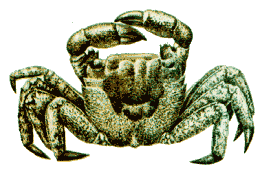 Synonyms: Cancer
marmoratus Fabr. 1788; Grapsus varius Latreillei 1867;
Grapsus marmoratus Grube 1861; Pachygrapsus marmoratus
Czerniavsky 1884, Casper 1951
Synonyms: Cancer
marmoratus Fabr. 1788; Grapsus varius Latreillei 1867;
Grapsus marmoratus Grube 1861; Pachygrapsus marmoratus
Czerniavsky 1884, Casper 1951Pachygrapsus marmoratus Fabriciu, 1787
 Synonyms: Cancer
marmoratus Fabr. 1788; Grapsus varius Latreillei 1867;
Grapsus marmoratus Grube 1861; Pachygrapsus marmoratus
Czerniavsky 1884, Casper 1951
Synonyms: Cancer
marmoratus Fabr. 1788; Grapsus varius Latreillei 1867;
Grapsus marmoratus Grube 1861; Pachygrapsus marmoratus
Czerniavsky 1884, Casper 1951
Common names: Bulg: Mramorniat rak; Rom: Crabul de piatra; Russ: Mramorny krab; Turk: Marmara pavuryasi; Ukr: Marmurovy krab
Order: DECAPODA
Family: GRAPSIDAE
Taxonomic descriptions: Large-size crab. Lateral side of front makes a straight angle with inner-orbital side. Front straight. Two evident epigastric lobs. Carapace with transversal thin vein. Merus of the 3-rd maxilliped with an evident interosuperior tooth. The chelipeds are short and thick. Pereiopods II-V longer than chelipeds; the IV-th the longest; the articles flattened. Dactylus short, flattened; superior and inferior side with spine and terminal claw. Female with large abdomen, almost circular; triangular form of male. Male with pleopods I strong; pleopod II reduced. Size: length - 38 mm; width - 43 mm. Colour: chesnut-reddish above; chela and dactylus are dark-brown; the inferior part of paws - ivory.
 IUCN Status:
IUCN Status:
World level:
Black Sea Regional level:
Subregion level: VU
Distribution:
Habitat type, Critical habitats, Limiting factors: In rocky middlittoral zone among rocks near the coast; at night goes out in the supralittoral zone. Common in Mediterranean Sea, Atlantic Ocean (coast of France and Morocco). In conditions of high floods of the Danube, this species goes to the deep bottom. Pollution of the marine waters with noxious chemical agents or the penetration of fresh water, particularly near the coast.
Biology: High prolificity; the main period of reproduction is in the middle of summer (July, August) when the water temperature reaches to 17oC; the period of incubation - 25 days; can live 3 years (rarely 4) and usually the female spawns in the 2nd year of life; somehow adapted for aerial respiration; it is a physiological species - cannot live in a medium with a chloride level under 10 ‰ or over 30 ‰.
Population trends: Abundant in 1960-1970 when hundreds of individuals were found on the rocky shores on the southern littoral (Eforie-Mangalia zones). After 1980 it became more rare; in recent years young individuals have been found in small quantities (3-4 specimens) in the southern rocky zones of the Romanian littoral.
Threats: Coastal pollution, coastal hydrotechnical constructions, hard frost in winter; a slight intake of fresh water in marine waters.
Conservation measures taken:
Conservation measures proposed: Reduce microbial pollution.
References:
Compiled by: C.Dumitrache